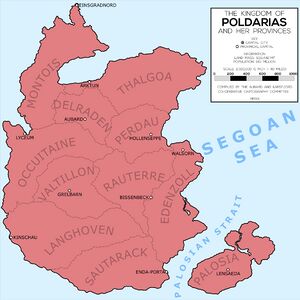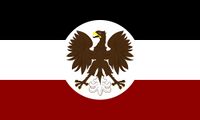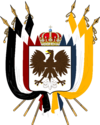Poldarias
The Kingdom of Poldarias de Koenigsa Poldarias | |
|---|---|
| Motto: Fau Gott, de Koenig und de Vollk For God, the King, and the People | |
 | |
| Capital | Lyceum |
| Largest | Aubard |
| Official languages | Poldarish |
| Ethnic groups (2015) | 97.6% Poldarion 1.8% Sudeeki 0.6% Aytherian |
| Religion | Kaloatism |
| Demonym(s) | Poldarion |
| Government | Unitary semi-democratic constitutional monarchy |
• Monarch | King Edward IX |
• Lord of the Privy Council | Francis Verschovanet |
• Imperial Minister | Thomas Beesley |
• State Minister | Archibald Crawford |
| Legislature | The Houses of Parliament |
| The House of the Privy Council | |
| The House of the Common Chambers | |
| Establishment | |
• Kingdom of Poldar | 1 BC |
| Area | |
• Total Area | 632,442 sq mi (1,638,020 km2) |
| Population | |
• 2020 estimate | 142,109,783 |
• 2015 census | 137,238,709 |
• Density | 217/sq mi (83.8/km2) |
| GDP (PPP) | 2015 estimate |
• Total | Ŧ7.318 Trillion |
• Per capita | Ŧ53,323 |
| GDP (nominal) | 2015 estimate |
• Total | Ŧ4.219 Trillion |
• Per capita | Ŧ30,742 |
| Gini (2015) | 26.4 low |
| HDI (2015) | very high |
| Currency | Thalar (THL) |
| Time zone | UTC+0 (PNT) |
| Date format | dd/mm/yyyy |
| Driving side | left |
The Kingdom of Poldarias, commonly referred to as Poldarias, Poldar or Pold is a sovereign nation located off the northwestern coat of the Segoan continent. It's landmass is compromised entirely of islands and thus shares no land boarders, instead being surrounded by Segoan Sea.
Poldarias is a Unitary semi-democratic with a constitutional monarchy. The current monarch is King Edward IX who has reigned since 2004. The monarch holds executive power in order to pass legislation discussed by the houses of Parliament into law. As it is common for the monarch to participate in governmental discussions, aided by the Privy council, it is uncommon for laws to be blocked.
Etymology
The name Poldarias derives from the old Poldarish word 'Pold', meaning folk. This later developed into the inhabitants of the islands inhabitents referring to themselves, and in turn being refereed to as the Poldars. This too developed, with the island becoming known as Poldarias by the 11th century.
History
Pre-historic era (before the 6th century BC)
The earliest evidence of humans on Poldarias are footprints found to date from 500,000 years ago. In addition to these footprints, other evidence located has been concentrated in the southern regions and the Great Plains due to their more hospitable climate, with the earliest inhabitants being hunter-gatherers. Low sea-levels meant that Poldarias and Palosia were attached to the continent of Segoa for much of this pre-historic period, and varying temperatures meant that the islands have not always inhabited.
Since the end of the last ice age in around 9,000 BC and the beginning of the the Mesolithic era, Poldarias has been continuously inhabited. The end of the Ice age resulted in rapidly rising sea levels, destroying the thin land bridge which had connected Poldarias to Segoa, abd flooding thr Palosia Strait. The population by then was exclusively anatomically modern humans, and evidence suggests that their societies became increasingly complex and they were manipulating their environment and prey in new ways, possibly selective burning of then omnipresent woodland to create clearings for herds to gather and then hunt them. It is this which resulted in the Great Plains forming due to the large populous which resided in the area. Hunting was mainly done with simple projectile weapons such as javelin and possibly sling. Bow and arrow was known in Western Europe since least 9,000 BC. The climate continued to warm and the population probably rose.
The New Stone Age, or Neolithic era, began with the introduction of farming in around 4,000 BC. It is not known whether this was caused by a substantial folk movement or native adoption of foreign practices or both. People began to lead a more settled lifestyle. Monumental collective tombs were built for the dead in the form of chambered cairns and long barrows. Towards the end of the period, other kinds of monumental stone alignments begin to appear, such as Stonehenge; their cosmic alignments show a preoccupation with the sky and planets. Other discoveries have resulted in the theory that the population of Poldarias were already aware of god, or another similar being.
The Bronze Age began around 2,500 BC with the appearance of bronze objects. This coincides with the appearance of the characteristic Beaker culture; again this might have occurred primarily by folk movement or by cultural assimilation or both. The Bronze Age saw a shift of emphasis from the communal to the individual, with the rise of increasingly powerful elites whose power came from their prowess as hunters and warriors and their controlling the flow of precious resources to manipulate tin and copper into high-status bronze objects such as swords and axes. Settlement became increasingly permanent and intensive. Towards the end of the Bronze Age, many examples of very fine metalwork began to be deposited in rivers, presumably for ritual reasons which has facilitated their long term survival, giving historians a good understanding of the times.
Antiquity era (6th century BC–1st century AD)
Around 240 BC, the Segoan Empire invaded and occupied much of the island of Poldarias. Their occupation was characterized by brutal treatment of the natives, with many Poldarions being killed or taken as slaves. This resulted in many natives fleeing the towns in which the Segoans established and lived in. The occupation of the island also introduced Segoan culture to Poldarias.
During this period, Kaloatism began to rapidly spread. Poldarions performed rituals, asking god (referred to as Kaloat) to send someone to liberate them from the Segoans, whom had begun to hunt down Poldarions as their number of slaves dwindled. In 50 BC, a man who became known as Gregory the Prophet traveled to the thousands of native Poldarion settlements, which by now had been pushed to the northern mountains, to speak of the liberation of Poldarias. He carried 11 stone tablets with him, which depicted exactly when and where their help would arrive. These included a calendar, which became known as the Gregorian calendar. This counted down until the 25th December 1 BC.
Kaloat era (1st–5th century)
On the 25th December 1 BC, a large number of native Poldarions followed the north star up to the northern tip of Poldarias. There, they witnessed a farmers wife giving birth as the tablets of Gregory the prophet had said. They hailed him as Christian, King of the Poldars and bestowed him with the title of 'Jesus', meaning saviour.
Christian worked on his parents farm until he was around 15. After this he, and many other Poldarions, began training for combat so they would be able to attack and drive out the Segoans. In 25 AD the Kaloat War began, with Poldarions using guerrilla warfare to continuously strike the Segoan army and administration. Fire boats sunk the Segoan ships which carried food and reinforcements, and most arable earth was set alight, being aided by unusually hot and long summers.
The battle of Enda-Fassau in 50 AD was the final event of war, and despite Christians age he was still determined to participate. The battle resulted in a victory for the Poldarions, however Christian was gravely wounded. A procession guided by Gregory carried Christian on a cross back to the mountains, being led into the Cave in which Gregory said he came from and lived in. After leaving the two in the cave, neither were seen again. Before he had died, Christian had a child who was then crowned king.
After the Segoans left the island and Christian died, a power vacuum emerged with numerous other leaders trying to take control of individual regions of the Island. The Poldar kingdom was soon reduced to a minor portion of its original size.
Early Middle era (5th–10th century)
Late Middle era (10th–15th century)
Early modern era (15th–19th century)
Contemporary era (20th century–present)
Geography
Climate
The majority of Poldarias has a semi-continental climate (abnormal Cfb), however due to the size and landscape of the Island there are a number of nuances to this:
- Areas on the western cost have a strictly oceanic climate (Cfb)
- Palosia and the southern isles have a Mediterranean climate (Csa and Csb)
- The mountain (or alpine) climates (Highlands: Dfb, Dfc and ET) are confined to the mountains in the north of Poldarias
Environment
Politics
Government
Poldarias has a Parliament consisting of two separate houses. The House of the Common Chambers consists of democratically elected representatives which discuss issues in their own constituencies. This allows issues raised at a local level which require a modification in statute law to be heard and solved by the necessary authority. The upper house of Poldarias' Parliament is the Privy Council - a body whose members are appointed by the reigning monarch. A representative is elected from the Common Chambers to liaise with the monarch so that laws can be passed, something only the monarch themselves can do.
Administration
The lowest level of the administration of Poldarias is the Parish or Municipal council, depending on the classification of the area, which manage local issues. Above this is the House of the Common Chambers which discuss regional and national in order to submit new laws or amendments to existing laws, and finally the House of the Privy Council who aids the monarch in their decisions.
Law
The court system in Poldarias operates under common-law principles. The essence of common law is that, subject to statute, the law is developed by judges in courts, applying statute, precedent and common sense to the facts before them to give explanatory judgments of the relevant legal principles, which are reported and binding in future similar cases. The courts of Poldarias are headed by the Senior Courts, consisting of the Court of Appeal, the High Court of Justice (for civil cases) and the Crown Court (for criminal cases). The Supreme Court is the highest court in the land for both criminal and civil appeal cases and any decision it makes is binding within all other courts.
In all cases a jury of 12 is present, and they alone must advise the judge how they find the defendant based upon the evidence, although the judge does not necessarily need to follow this finding. The right to be held innocent until proven guilty is enshrined by law.
Foreign Relations
In order to protect its colonial and trade interests, Poldarias has always been an active member of the international community. Following the end of the First Grylon War in 1924, Poldarias became a founding nation of the United Council of Nations.
Poldarias maintains good relations with a number of nations, notably The Kingdom of Blayk, The Grand Duchy of Florinia, The Republic of Rythene, The Socialist Federation of The Democratic Soviet Union, The Grand Kingdom of Tyrnica, and The Grand Kingdom of Vervillia.
Military
The armed forces of the Poldarias – officially, His Majesty's Armed Forces – consist of three professional service branches: the Royal Navy and Royal Marines, the Poldarian Army and the Royal Poldarian Air Force. The armed forces are managed by the War Office and controlled by their own respective ministries and councils. The Commander-in-Chief is the Poldarian monarch, to whom members of the forces swear an oath of allegiance.
Poldarias' military is relatively large, consisting of 1.1 million service personnel. This allows for a global presence, on international exercises or as part of a Colonial Garrison. The last major conflict the Poldarian armed forces were involved in was the Aytherian civil war.
Economy
A system of self-sufficiency is employed within Poldarias in order to ensure that essential goods can be produces and manufactured without the aid of another nation. As a result of this certain technologies, notably within the computing industry, are underdeveloped.
A number of major industries and public services are state owned, however private industry remains common. There are strict regulations on how large a business is permitted to expand, resulting in local stores as opposed to chain stores, for example.
Agriculture
Due to the system of self sufficiency in place, food is of vital importance for Poldarias with very little being exported. Wheat, poultry, dairy, beef, pork and vegetables are the primary goods produced.
Energy
Coal is the fundamental source of energy in Poldarias owing to the huge deposits within the country. Hydroelectric dams are the second most common, with more being constructed in order to alleviate the reliance on coal.
Industry
Infrastructure
Transport
The primary method of transport in Poldarias is rail, with over 50,000 miles of track being operated by the State-ran National Rail Network which only operates steam locomotives. Cross country travel is done via high speed sleeper trains with a speed of 110 miles per hour. Within inner cities trams, buses and underground subways operate extensively in order to alleviate congestion.
Vehicle ownership in 2015 was 31 million owing to the comparatively low cost of traveling by public transport. Poldarias only has 234,468 miles of paved road, compromised mostly of motorways and roads within cities.
Science and Technology
Water supply and sanitation
Access to improved water supply and sanitation in Poldarias is universal. It is estimated that 94.6% of households are connected to the sewage network. Drinking water standards and wastewater discharge standards in Poldarias are managed by the Ministry of Health.


